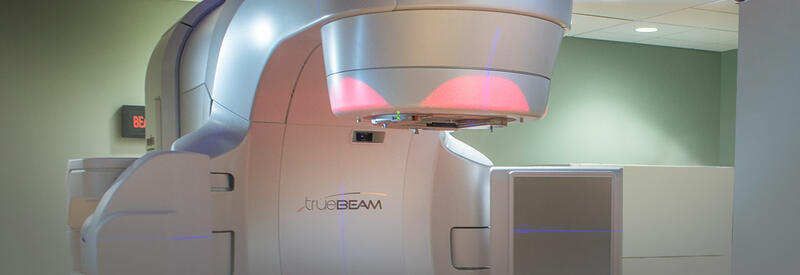

Radiation Oncology

Our radiation oncology team wants each patient to understand his or her diagnosis and treatment by knowing what to expect and how to prepare. Patients are encouraged to ask questions and to share concerns.
Morrison Cancer Center is committed to you, providing the best treatments, the most advanced technology and a passion for innovation. Our caring staff, family atmosphere, and strength of spirit are here for you.
What is a Radiation Oncologist?
A radiation oncologist is a physician who directs your radiation treatments and care while you are undergoing radiation therapy. Your first appointment will be spent discussing and understanding your diagnosis as well as options for treatment. The first day may also include a planning CT (simulation planning scan) that allows measurements while you are in the treatment position.
Use of Radiation Oncology
Radiation is used for local elimination of malignant cells. Side-effects of radiation treatment can be temporary or permanent. The radiation oncologist will explain the specific treatment and side-effects in detail.
Radiation therapy is very precise. Advancing science continues to unveil new treatments useful for treating particular types of cancer. External radiation is delivered with a linear accelerator using ultra-modern methods to focus treatment on uniquely-shaped tumors while sparing healthy tissue.
TrueBeam® Radiotherapy System The TrueBeam® linear accelerator brings leading edge cancer care to the Hastings community by positioning Mary Lanning Healthcare at the forefront in the fight against cancer. Designed from the ground up to treat moving targets with advanced speed and accuracy, the TrueBeam platform is a fully-integrated system for image-guided radiotherapy and radiosurgery. The TrueBeam system treats cancer anywhere in the body where radiation treatment is indicated, including lung, breast, prostate and head and neck. Technologies such as motion management, integrated imaging and high dose rates are some of the tools that are required for the delivery of advanced treatments like stereotactic body radiation therapy.
The carefully guided, automated workflow on the TrueBeam system uses intuitive visual cues to enhance safety and reduce operation times so patient throughput can be optimized. Streamlined imaging and patient positioning tools enable more flexibility to treat clinical cases throughout the body. Having the power to not only treat quickly, but to deliver high, accurate dose rates are hallmarks of the TrueBeam system.
Intensity-Modulated Radiotherapy (IMRT) is an advanced type of radiation therapy used to treat cancer and noncancerous tumors. IMRT uses advanced technology to manipulate photon beams of radiation to conform to the shape of a tumor while sparing surrounding healthy tissue.
Stereotactic Radiation Therapy (SRS and SBRT) Stereotactic radiosurgery (SRS) is a non-surgical radiation therapy used to treat functional abnormalities and small tumors of the brain. It can deliver preciselytargeted radiation in fewer high-dose treatments than traditional therapy, which can help preserve healthy tissue. When SRS is used to treat body tumors, it’s called stereotactic body radiotherapy (SBRT). Lung cancer candidates for SBRT are patients with small tumors, five centimeters or less, who are poor candidates for surgery due to the risk of functional deficit.
Image Guided Radiotherapy (IGRT) uses reference images that are fused with images taken during treatment to precisely localize the treatment target.
Optical Surface Management System (OSMS) is a video-based three-dimensional (3D) surface imaging system, which is used to image the skin surface of a patient in 3D before and during radiotherapy treatment. If movement from the reference position is detected, such as during the breathing cycle or if a patient sneezes or coughs, the software calculates new co-ordinates to adjust the treatment couch for optimal positioning.
Real-time Position Management™ (RPM) Respiratory Gating The Varian Real-time Position Management™ (RPM) system is a non-invasive, video-based system that allows for clean imaging and treatment of lung, breast, and upper abdominal sites. This system allows clinicians to correlate tumor position in relation to the patient's respiratory cycle. Using an infrared tracking camera and a reflective marker, the system measures the patient's respiratory pattern and range of motion and displays them as a waveform. The gating thresholds are set when the tumor is in the desired portion of the respiratory cycle. These thresholds determine when the gating system turns the treatment beam on and off.
The Varian PerfectPitch™ 6 degrees of freedom (6DoF) couch is designed to deliver advanced radiation therapy techniques with a high level of accuracy and reproducibility. Increasing clinical evidence suggests that a robotic couch with 6 degrees of freedom used in conjunction with cone-beam computed tomography (CBCT) may reduce patient set-up errors and improve target positioning for high-dose stereotactic treatments and IMRT.
High Dose Rate Brachytherapy (HDR) is a type of internal radiation therapy that delivers radiation from implants placed close to, or inside, the tumor(s) in the body. Because cancer often affects organs and other essential structures, it is important for radiation treatment to be tightly focused on tumors to minimize serious side effects. This technique ensures the maximum radiation dose is given to cancerous tissues, while minimizing exposure to the surrounding healthy tissue. HDR treatment for partial breast radiation of early-stage breast cancer offers radiation in five days compared to seven and half weeks of standard, external therapy.





